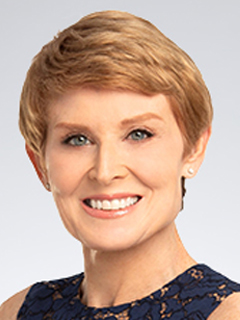
Economic Compass
Bye, bye Miss American Pie
The outlook: inequality and consumer angst
October 8, 2025
“Drove my Chevy to the levee, but the levee was dry…”
-American Pie, 1971
Don McLean’s hit “American Pie” was an anthem for the social and economic turbulence of the 1960s and 1970s. The first time I heard its iconic chorus, it captured the longing for a time when the world felt less divided. It seemed to encapsulate an unease about the future that my parents expressed at the dinner table.
I came of age in the industrial Midwest as layoffs mounted and factories rusted. I watched the middle class shrink as the heartland became the “Rust Belt.”
Some inequality is natural and inherent in a market-based economy. It reflects differences in skill, grit and luck, which sow the seeds of competition. Extreme inequality is not; it triggers discontent, social unrest and is more corrosive than conducive to growth.
We are already seeing the effects of increasing inequality. Consumer attitudes fell again in August and September, despite an economy that looks stronger than just about anyone expected for the third quarter.
Concerns about inflation and the labor market are elevated, a combination we have not seen since the 1970s. The emerging stagflation is not the same but evokes a visceral response. Higher prices at the grocery store are hard for households to swallow.
The outliers are those who make over $200,000 a year and have large stock holdings. They are more optimistic about the economy. Anything that shakes their confidence could tip the apple cart.
Add a government shutdown and consumer attitudes could further sour. The 35-day shutdown of 2018-19 was disruptive. Consumer spending plummeted in December 2018; it took three months to regain ground lost.
This edition of Economic Compass takes a closer look at income and wealth inequalities, how those shifts are reshaping the economy and the risks to growth. The economy is becoming more dependent upon the most affluent to keep spending and is more susceptible to stock market corrections.
Special attention is paid to the challenge these shifts pose to the Federal Reserve. We are still expecting the Fed to cut short-term interest rates twice before year-end. A prolonged government shutdown would increase those odds, while a quick resolution lowers them.
The shutdown alone could shave 0.2% from real GDP growth per week but losses are nonlinear. Efforts by the administration to freeze spending and implement more permanent layoffs could up those costs.
The outlook
Tepid gains
The economy is expected to slow from a 2.8% annual pace in 2024 to the 2% range in 2025 and 2026, before slowing further in 2027. That leaves us with the two weakest back-to-back years since the early 2010s.
The data on GDP growth and the labor market are diverging. GDP growth was revised up, even as payrolls were revised down. That is unusual.
The demand and supply of workers have dropped in tandem, which has left the unemployment rate near historic lows. Churn in the labor market has come to a virtual standstill. Those who have a job are frozen in place; those without are frozen out.
The breakeven on payroll employment necessary to keep the unemployment rate from rising has plummeted. The economy needs between 30,000 and 60,000 new paychecks a month to hold the unemployment rate in check. That is down from 155,000 in 2024.
Additional curbs on immigration could push that threshold into negative territory in 2026. That means the overall unemployment rate could remain unchanged if payrolls slip into the red. It is mind boggling.
That leaves economic growth in the hands of a privileged few. Anything that dents their confidence could trigger a broader slowdown in consumer spending and the overall economy.
The threat of a stock market correction is a potential headwind. Foot traffic in luxury retailers disappears on days of large stock market corrections.
Asset prices are frothy
There is little doubt that we are in an asset price bubble. Measures of price-to-earnings ratios have reached their highest levels since the dot-com bubble of the early 2000s. (See Chart 1.)
A correction in stock values is likely over the next two years, but timing it is difficult. Even signs that the AI bubble is becoming self-feeding, with tech firms paying each other to keep it afloat, have not yet raised red flags.
Risks. A prolonged government shutdown, a sharp stock market correction and additional shifts in trade policy represent downside risks to the forecast. Threats of tariffs on foreign-made movies, which would expand tariffs to the service sector, could trigger retaliation. The tech and finance sectors are most vulnerable.
Curbs to immigration are another hurdle as they limit the supply of workers. We are doing more with less, but it is too early to see the boost to productivity growth due to AI.
AI adoption among large firms slid over the summer. That is despite the boom in construction of the data centers needed to run the large language models.
Chart 1: Price-to-earnings ratios near record high
Shiller Cyclically Adjusted S&P Price-to-Earnings Ratio (CAPE)
Worsening inequality
A 20% economy
Chart 2 shows recent work done by Moody’s Analytics on income inequality and shifts in consumer spending. The top 20% of households - those making over $175,000 annually - outpaced overall inflation with their spending since 2021. An even smaller 3.3% of households drove those increases. The bottom 80% have barely kept up with inflation.
The top 20% of earners now account for roughly two-thirds of all consumer spending, a new record. Their cushion on savings has moved up, while the bottom 80% are tapped out. They have depleted their savings, are taking on debt and suffering an increase in delinquencies.
Student loan delinquencies hit an all-time high of 13% in the second quarter. That tops the previous peak in 2013, when the economy was still struggling to recover from the Great Recession. More student loan problems are in the pipeline, which will limit the access those households have to debt.
Chart 3 shows the distribution of wealth and how it has shifted since 2019. The top 10% of households held more than two-thirds of wealth in the US in the second quarter, another record. The top 1% held almost a third. The bottom 50% held only 2.5%, mostly in their homes.
One of the strongest determinants of a child’s future income is the zip code in which they grow up. Affluent zip codes boost children’s access to education and networks necessary to move up in income strata. Poorer families who move to better neighborhoods can shift the economic fortunes of their children.
That is becoming more of a pipe dream. The number of those moving for a job has fallen in recent decades. Homeowners who locked in ultralow rates are not moving, while labor churn has come to a near standstill.
Only the most affluent can afford to relocate, especially for a job. That means that any boost in income due to job hopping accrues to those households. Rinse, wash, repeat. A cycle of escalating inequality is emerging.
Chart 2: High income individuals powering consumer spending
Personal outlays by income group, index, Q4-2019=100
Chart 3: Upper-income households better positioned to drive consumption
Net worth, $ trillions
Decades in the making
Income and wealth inequalities have been worsening for decades. The most cited reasons in the economic literature are technological innovation and globalization. We failed to make whole those displaced by innovation and trade. Spoiler: The job losses due to innovation are greater than those lost to trade.
Other top factors are uneven access to education and healthcare, shifts in tax and spending policies, the rise of monopsonies, hiring biases and an erosion of labor protections. Union membership peaked at a third of all workers in the mid-1950s; it dropped below 10% last year, a post-war low.
Another major setback was the Great Recession, which dealt a blow to current and lifetime earnings of those who graduated into the subpar recovery. Millennials top the list; it forced them to delay milestones such as marriage, homeownership and having children.
The threat posed to workers by innovations in AI represents yet another disruption. Forecasts of job displacement are all over the place; most are larger than any previous innovation.
Negative consequences
The Gatsby Curve
Famed labor economist Alan Krueger dubbed the correlation between income inequality and lower growth prospects “The Gatsby Curve.” It was named for F. Scott Fitzgerald’s 1925 classic novel, The Great Gatsby, which chronicled the inequality that occurred in the early part of the 20th century.
The “curve” is more of a straight line, which maps the performance of economies against the distribution of their incomes. Economies with a more equal distribution of income have tend to perform better than those with more inequality.
High levels of inequality are more prevalent in developing than developed economies. Brazil is an example. It performs worse than an economy such as Denmark, where income is more evenly distributed.
Are we close to a tipping point?
Research by the International Monetary Fund (IMF)and World Bank suggests that the US may be on a precipice. Countries with greater levels of income inequality tend to perform worse.
Specifically, researchers found that countries with a Gini coefficient of 40 or above performed worse than countries with a Gini coefficient less than that. The Gini coefficient is a measure of income inequality.
In theory:
- A Gini coefficient of 0 means perfect equality; everyone earns the same amount of money.
- A Gini coefficient of 100 means perfect inequality; one person has 100% of the income generated.
In reality, all countries lie somewhere between those two extremes. The research simply identifies a possible tipping point, which is 40.
Chart 4 shows the trajectory of the Gini coefficient in the US. The post-WWII drop in inequality hit a wall and reversed course in the late 1970s. It has been on an uptrend ever since, with a brief pause in the late 1990s and during the pandemic.
By 2023, the Gini index was 41.8, the second highest on record. It likely worsened in 2024 and 2025, given the trends. That leaves us looking more like a developing economy and reinforces the case for speed bumps.
Chart 4: Inequality on the rise in the US
Index, 0 = perfect equality, 100 = perfect inequality
How does inequality dampen economic growth?
Research by the IMF reveals four ways in which highly unequal economies dampen growth:
- Reduced consumer spending. Low- and middle-income consumers tend to spend more of each dollar earned than high-income consumers. When income inequalities are high, less of each dollar earned is spent, which dampens consumer spending.
Inflation worsens inequality and inequality buoys inflation. Demand by affluent consumers amplified the post-pandemic inflation. A rise in all-cash purchases of homes and vehicles continues to undermine affordability in those markets. - Debt-ridden fragilities. In response, low- and middle-income households tend to turn to debt to make ends meet. They double down as the basics of food, shelter and transportation become less affordable. That can trigger debt crises. The subprime mortgage crisis and collateral damage caused by the bursting of the housing bubble is one example.
Affluent households can afford riskier investments to boost their returns. That precipitates asset price bubbles. New asset classes are the most vulnerable. Crypto and the rapidly growing private debt market fall into that category. - Reduced investment in human capital. High inequality increases the hurdles to education and health care. That undermines talent development and the ability for those with high potential to escape poverty.
- Social unrest and an erosion of trust. Inequalities breed resentment and stoke political divisions. Those shifts erode trust in institutions and a sense of fairness, the oil of the market machinery. Transaction costs rise, which adds to inefficiencies and further undermines growth.
History is littered with revolutions based on such outcomes, too many of them bloody. The backlash to technological innovation cannot be overstated and needs to be a part of how we navigate the unique attributes of innovations in AI. The KPMG AI survey reveals that more than 40% of firms are adopting AI agents, which are already reshaping call centers.
Implications for the Fed
A no-win situation
The Fed is dealing with a multitude of risks that leave it with few easy choices:
- The bulk of the effects of tariffs are still ahead of us, which ups the risk of higher unemployment and inflation.
- The war on the inflation we endured emerging from the pandemic was never won.
- Service sector inflation could be buoyed by the skew in demand by affluent households.
- Financial market fragilities are rising, sowing the seeds of a larger correction in asset prices.
- The Fed remains “data dependent” in a world devoid of some of the most important data due to the government shutdown.
- Trust in the Fed and other institutions has fallen; any further increase in price levels and deterioration in the labor market will add to that drop.
That has left the Fed cautiously, instead of decisively, cutting rates. We expect the Fed to cut rates two more times this year, but that is not a slam dunk. The pace of rate cuts is expected to be more measured at the start of 2026 and accelerate with a leadership change in the second half.
Jay Powell has been guarded about whether he will stay on the Board of Governors after his term as chairman lapses in May 2026. His term as a governor lasts until January 2028. He wouldn’t be the first to make that decision, but it is unusual.
Risks: The Fed is left in a no-win situation. If it cuts too aggressively, it could stoke a more persistent bout of inflation. If it fails to cut rates fast enough, it could trigger more pain in the labor market.
That is prior to worrying about risks of financial market stability, which is within the Fed’s purview. Consumer debt levels are nothing like what we saw in the years leading up to the Great Recession. Private debt vehicles for small- and middle-market firms are more of a concern.
There are the threats posed by the shutdown itself. The longer it lasts, the more it costs the economy.
Finally, the Fed only controls short-term rates, not long-term rates. Long-term Treasury bond yields have rebounded following the September rate cut much like we saw a year ago. Concern about inflation and a continued rise in debt and deficits are creating a floor under how low bond yields and other rates can go.
Bottom Line

Inequalities in incomes and wealth have left the economy looking better on paper than it feels to most Americans. Affluent households are playing Atlas and carrying consumer spending. That concentration creates its own headwinds to growth, while stoking the political divisions we are enduring.
The shifts mimic the arc of McLean’s iconic song, which starts reflecting on the past and the hope of a different era. It ends with a sense of hopelessness and the shattered dreams of a generation. That seems an apt metaphor for where we are, decades later.
McLean left the interpretation of the lyrics deliberately ambiguous, so everyone would find their own meaning. We keep attempting to decode it together. Perhaps that is the song’s paradox; we use individual interpretations to find a shared meaning, which could bring us closer together. Hope springs eternal. Be kind; pay it forward.
Summer heat, autumn chill
Real GDP rose at an estimated 3.3% annualized pace in the third quarter, slightly behind the upwardly revised 3.8% pace of the second quarter. Consumer spending accelerated. Housing activity lost ground. Business investment got a lift from easier credit conditions, the AI boom and tax credits for investment. Inventories remained bloated. Government spending rebounded with the end of the continuing resolution. The trade deficit narrowed, with imports falling faster than exports.
Real GDP is forecast to rise only 1% in the fourth quarter, its weakest pace since the first quarter. Consumer spending is poised to slow as tariffs work their way through supply chains. Housing remains in the doldrums. Business investment will weaken. Inventories drain. The trade deficit narrows. Government spending is contingent upon the length of the shutdown.
The government shutdown could shave 0.2% per week from real GDP growth in the fourth quarter. A contraction cannot be ruled out. Historically, GDP recoups much of what is lost to furloughs after the government reopens, as federal workers are paid in arrears. This time could be different, given the suspension of funding to key states and threats of more permanent layoffs.
Fed poised to cut further. The Fed is poised to cut two more times before year-end, but the second cut is not a done deal. A significant minority among the Fed’s leadership would like to take a more measured approach to cuts. The outlook for rate cuts in 2026 is contingent upon changes in the leadership within the Fed as well as shifts in the economy. We expect to end 2026 with rates below the threshold the Fed currently considers neutral, and monetary policy to move into stimulative territory.
The course of bond yields is becoming less certain, given ongoing inflation and increases in federal debt and deficits. Fiscal 2025 came in worse than forecast by the Congressional Budget Office.
Economic Forecast — October 2025
Dive into our thinking:
Explore more

Birds of a feather no longer flock together
The Fed splits over timing & size of rate cuts.

KPMG Economics
A source for unbiased economic intelligence to help improve strategic decision-making.

Policy in Motion: Insights for navigating with confidence
Your resource for the latest on trade, tariff and regulatory policy changes.
Subscribe to insights from KPMG Economics
KPMG Economics distributes a wide selection of insight and analysis to help businesses make informed decisions.
Meet our team
